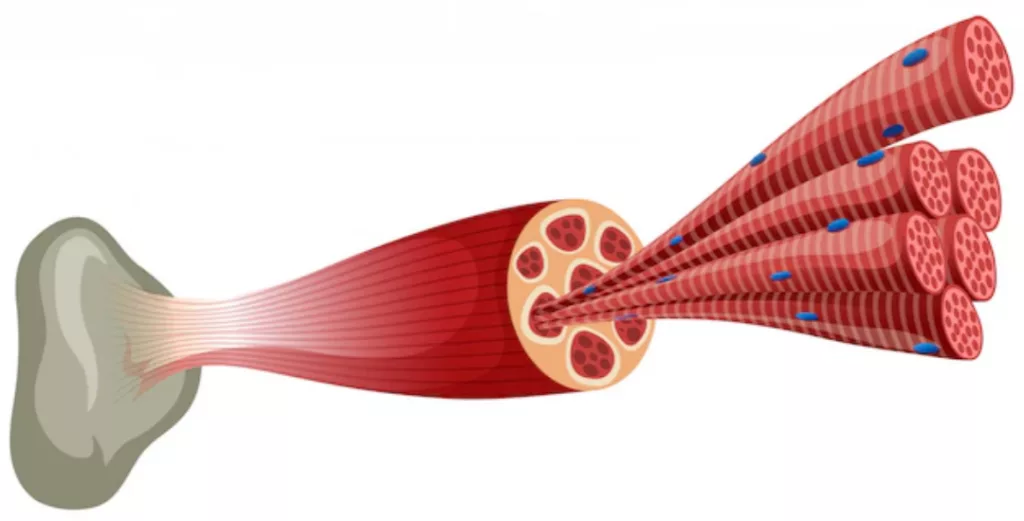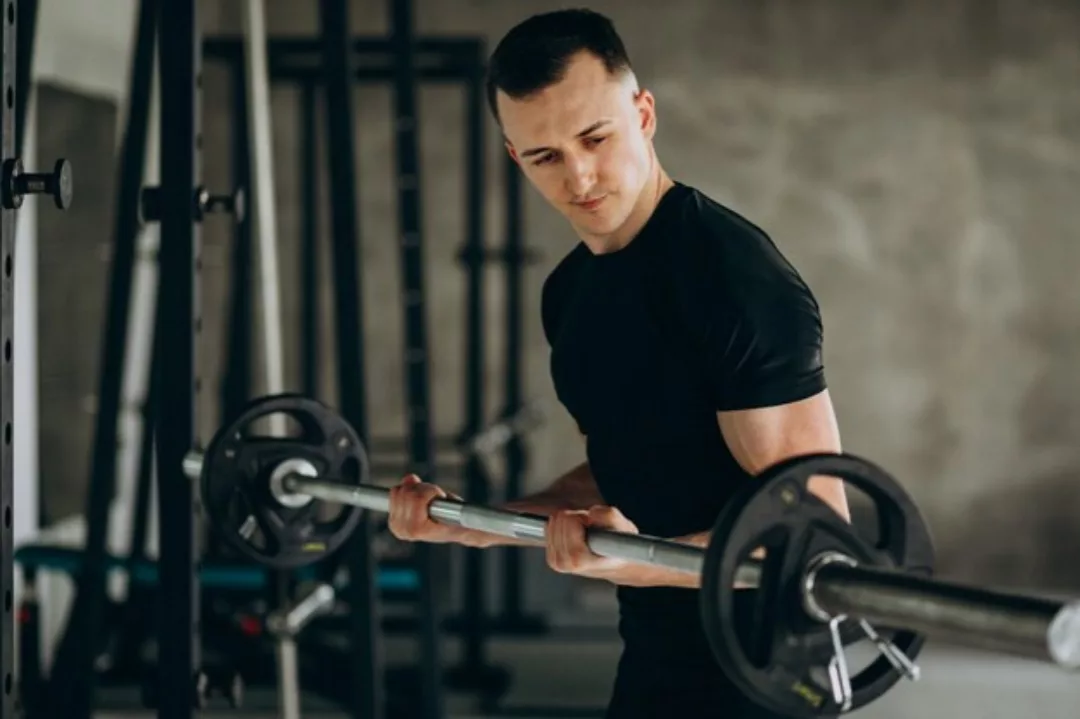The first time I walked into the gym feels like yesterday.
I was 18, full of energy, ready to lift the world.
The trainer?
A big guy, but not a giant.
One of those who truly knew his stuff.
He sees me at the lat machine, lets out a sigh, and says:
“Drop your shoulders, that way you activate your lats!”
And me?
Skeptical.
“What are you talking about? I want to push hard!” I thought.
He shakes his head and patiently explains:
“If you don’t focus on the muscle you need to activate, you’re just pulling with your arms and wasting energy.”
That’s when I realized that the real secret to muscle growth wasn’t just the load, but how I moved it.
That’s why today we talk about repetition speed and how it affects strength, hypertrophy, and endurance.
The Fibers Involved: Slow vs Fast

When you slow down your repetitions, every muscle fiber is forced to give its all.
Imagine watching a slow-motion replay of an athletic move: you notice every detail, every contraction.
This approach lets you feel the muscle working during every phase of the movement.
Sure, it might seem like an “expert bodybuilder” trick, but there is solid scientific backing behind this technique.
Studies show that a longer time under tension leads to greater muscle activation.
Slow repetitions activate muscle fibers differently than fast ones.
When you perform a movement slowly, you more intensely engage the slow-twitch fibers—those responsible for endurance and stability.
On the other hand, fast repetitions stimulate the fast-twitch fibers, which are useful for explosive strength and power.
Speed in the Concentric Phase: What Science Says

The phase in which you lift the weight should be performed more quickly than the lowering phase.
In general, a concentric execution in about 1 second, followed by a controlled descent of 2–3 seconds, is effective for most training goals.
For example, during the bench press, push the weight in 1 second and then lower it slowly in 2–3 seconds.
This pattern also works well with other exercises like bicep curls and pull-ups.
If your goal is to achieve greater explosiveness and best stimulate your muscles, an energetic concentric phase is particularly recommended.
On the other hand, if you want to improve control and extend muscle activation, slowing down the eccentric phase becomes essential.
In short, the ideal speed in the concentric phase combines power and efficiency without sacrificing proper technique.
Repetition Speed: Which One is Best for Strength, Mass, and Endurance?
Every gym goal requires a specific execution speed.
Let’s see how to adjust the pace based on different objectives:
Strength Training
- Concentric (pushing or lifting phase): Explosive (0.5–1 second)
- Eccentric (lowering or returning phase): Controlled (about 2 seconds)
- Pause between phases: Minimal or none
Why?
You need to recruit the maximum muscle fibers quickly.
Think of deadlifts or the bench press: you can’t lift a maximum weight slowly; you must push with everything you’ve got!
Practical example: 3–5 repetitions with 85–95% of your one-rep max.
When done correctly, your nervous system will adapt to recruit more fibers faster, making you stronger.
Muscle Mass (Hypertrophy) Training
- Concentric: Moderate (1–2 seconds)
- Eccentric: Slow and controlled (3–4 seconds)
- Pause between phases: 1 second to maximize TUT (Time Under Tension)
The goal is to stress the muscle for as long as possible.
The longer the muscle works, the more it grows.
Practical example: 8–12 repetitions with 70–80% of your one-rep max.
Want a devastating experience?
Try a squat: lower in 4 seconds, pause for 1 second at the bottom, and rise in a controlled 2 seconds.
Burn, right?
Welcome to hypertrophy.
Endurance Training
- Concentric: Moderate (1–2 seconds)
- Eccentric: Controlled but not too slow (2–3 seconds)
- Pause between phases: None or very short
Here the goal is to make the muscle work for longer periods without fatiguing immediately.
Practical example: 15–20+ repetitions with 50–65% of your one-rep max.
Great for endurance athletes, fighters, or anyone looking to improve long-term muscular stamina.
Summary of the Differences in Execution Speeds
| Objective | Concentric | Eccentric | Pause | Ideal Reps |
|---|---|---|---|---|
| Strength | Explosive (0.5–1s) | Controlled (2s) | Minimal | 3–5 |
| Mass | Moderate (1–2s) | Slow (3–4s) | 1s | 8–12 |
| Endurance | Moderate (1–2s) | Controlled (2–3s) | Very short or none | 15–20+ |
Mind-Muscle Connection: The Secret to a Perfect Workout
Have you ever seen a bodybuilder in a trance while performing a repetition?
They aren’t just randomly pushing weights.
They are feeling every single fiber of the muscle working.
This is the essence of the mind-muscle connection.
Scientific studies confirm that awareness during training truly makes a difference.
A recent study examined whether focusing on using specific muscles during the bench press could increase their activation.
Eighteen trained men were tested, performing different versions of the bench press at varying intensities, ranging from 20% to 80% of their one-rep max.
The results showed that concentrating on the target muscle (whether the pectoralis major or the triceps) increases muscle activity at loads from 20% to 60% of the max.
Beyond 60%, however, there appears to be a threshold: the increase in activity does not continue in a linear fashion.
Interestingly, focusing on one muscle does not lead to a decrease in activity in the other.
In fact, concentrating on the triceps can even boost pectoral activity at moderate loads.
Advanced Techniques for Mindful Training
The brain-muscle connection is not an innate talent—it must be nurtured and trained day after day.
It’s not enough to perform slow repetitions; a parallel mental effort is needed.
Take, for example, “visual training.”
Close your eyes for a moment before starting a set.
Clearly imagine the muscle you are about to work.
If you’re about to do a bicep curl, visualize the muscle contracting perfectly as you lift the weight.
Think of every fiber lighting up and working.
This simple exercise prepares your brain to “talk” to the muscle, establishing a stronger connection.
Slow vs Fast: Which Connection is Better?
Slow repetitions → Greater control, better mind-muscle connection.
Fast repetitions → More explosiveness, but less awareness of the movement.
Slow repetitions force you to focus on the right muscle, preventing other muscle groups from compensating too much.
For example, a slowly executed bicep curl prevents you from using your shoulder or back as a crutch.
When and Who Should Use Slow Repetitions?
Beginners: Control First, Then Speed
If you’re just starting out, it doesn’t make sense to jump straight into slow, heavy repetitions.
It’s better to learn the technique with a manageable load and controlled, yet not exaggerated, repetitions.
Intermediate and Advanced: The Right Mix
If you already have experience, you can alternate between different speeds depending on your goal.
For example, when I want to improve a specific muscle group, I include slower sets in my workouts.
Leg day?
A slow squat to burn more.
Chest?
A controlled bench press to feel every fiber.
How I Blend Different Rep Tempos
When I want to vary my training, I mix sets of slow, controlled, and fast repetitions to stimulate the muscles in different ways.
For example, I dedicate at least one week per month to “slow sessions.”
On these days, I focus exclusively on controlled repetitions, lowering and lifting the weights with an almost meditative slowness.
The sensations are distinctly different: I feel every muscle fiber at work, notice a reduction in post-workout soreness, and gain greater awareness of my posture.
But I don’t stop there.
In other sessions, I alternate between normal sets and explosive ones.
For instance, in a single workout I might start with a medium-paced warm-up set, continue with sets of slow repetitions to activate the muscle, and then finish with explosive sets that give me an adrenaline rush.
This combination allows me to work on both neuromuscular efficiency and the ability to generate dynamic strength.
Another approach I use is “cluster sets.”
Here, I divide a set into mini-intervals: performing 3–4 fast repetitions, then taking a short break of 10–15 seconds before resuming the set.
This way, I keep the intensity high and fully exploit my explosive power without compromising movement quality.
Additionally, alternating speeds helps prevent muscle adaptation, ensuring constant new stimuli and continuous growth.
My advice is to experiment: vary the rest intervals, execution times, and loads.
Try dedicating part of your week to sets that emphasize control and precision, while in other sessions focus on explosiveness.
This strategy makes training more dynamic, reduces the risk of plateaus, and helps you understand which combinations yield the best results.
How Many Repetitions for a Perfect Connection?
Generally, a range of 8–12 repetitions is optimal for improving the mind-muscle connection.
In some cases, however, you can experiment with heavier weights and fewer repetitions, lowering the number to 5–7 to intensely focus on contraction quality.
The key is always to listen to your body and not push too hard, thereby avoiding compromising your technique.
Application on Different Muscles
The mind-muscle connection works for all muscle groups, but some muscles respond better than others.
For example, smaller muscles such as those in the arms and shoulders benefit enormously from increased focus.
Larger muscle groups, like the legs and back, require a balanced management between speed and intensity.
Not Just the Gym: Other Disciplines
The mind-muscle connection is not limited to the gym.
Even in other sports such as Olympic weightlifting, CrossFit, and even disciplines like yoga, this awareness of movement is crucial.
This practice helps improve coordination, balance, and overall performance.
RELATED:》》》 Can a Beginner Use 5×5 to Gain Both Strength and Size?
Final Thoughts
In conclusion, slowing down your repetitions does not simply mean moving more slowly.
It’s a way to truly connect with every muscle in action.
Experimenting with execution times has taught me to feel every fiber at work, making each set unique.
I have learned that it’s not just about lifting weights, but about listening to your body and improving step by step.
With the right mix of control and awareness, every repetition becomes an opportunity to grow.
Find your rhythm, let yourself be guided by the sensation, and don’t be afraid to vary the tempos.
My experience has shown me that small adjustments can lead to great results.
Let me know in the comments if slowing down your repetitions has truly benefited your training or if you have found other techniques more effective for you!
FAQs:
❓ Is it counterproductive to train only with slow repetitions?
Training exclusively in a slow manner can lead to imbalanced development.
A variety of speeds stimulates different muscular adaptations.
❓ Are fast repetitions dangerous?
If performed without control, they can increase the risk of injury.
It is important to master the technique before increasing the speed.
❓ Can I alternate between modalities in a single session?
Absolutely!
A good strategy is to start with a technical phase using slow repetitions and then move on to more dynamic movements.
❓ Does breathing really matter?
Yes, proper breathing improves movement control and muscle oxygenation.
❓ Does using heavy weights compromise the mind-muscle connection?
Not necessarily, but it is advisable to start with weights that allow you to execute the movement in a controlled manner.

